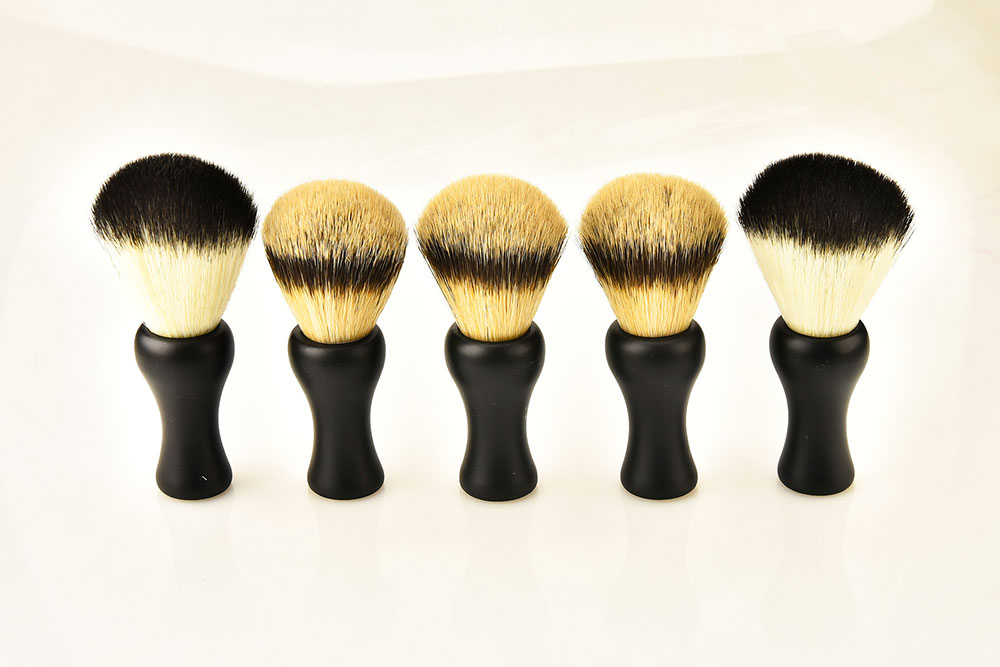Industry news
Shaving Brush Handle Designs: Ergonomics and Aesthetics in Harmony
- 376 Views
- 2025-07-13 02:31:07
Shaving Brush Handle Designs: Ergonomics and Aesthetics in Harmony
The shaving brush is more than a tool—it’s the centerpiece of a ritual, where functionality meets daily indulgence. At its core lies the handle: a component that bridges practical use and sensory pleasure. Today, we explore how modern shaving brush handle designs master the art of balancing ergonomics (the science of comfort) and aesthetics (the language of beauty), creating pieces that feel as good as they look.
The Ergonomic Foundation: Comfort Beyond Intuition
Ergonomics in handle design is rooted in understanding how the human hand interacts with an object during use. A well-designed handle minimizes strain, enhances control, and turns a routine task into a comfortable experience. Key elements include:

Grip Geometry: The shape of the handle directly impacts握持 stability. Traditional cylindrical handles, while classic, often lack contouring for the natural curve of the palm. Modern designs address this with subtle tapers (wider at the base for secure holding, slimmer at the top to reduce wrist pressure) or ergonomic bulges that align with the thumb and fingers. For example, a handle with a slight waist at the midpoint encourages a relaxed, neutral grip, preventing the need for excessive force that leads to hand fatigue during a 5–10 minute lathering session.
Weight Distribution: A handle that’s too heavy strains the wrist; too light feels flimsy and reduces control. Optimal balance is achieved by positioning the center of mass slightly below the brush head, ensuring the tool “hangs” naturally in the hand. Materials play a role here: dense woods like ebony add heft without bulk, while lightweight resins (reinforced with fiberglass for durability) offer stability at a lower weight. Our in-house testing shows that handles weighing 85–105g strike the ideal balance for most adult hands.
Tactile Feedback: The surface texture matters as much as shape. Smooth, polished metals may look sleek but can become slippery when wet—a critical flaw during shaving. Instead, designers now integrate subtle textures: hand-rubbed wood grains that provide friction, matte resin finishes that repel moisture, or even silicone inserts at key grip points. These details ensure the handle stays secure, even with soapy hands.
Aesthetics: Crafting Beauty That Serves Function
Aesthetics in handle design is not mere decoration; it’s about enhancing the user’s connection to the product. A visually appealing handle elevates the shaving ritual, making it feel intentional and luxurious. Key aesthetic elements include:
Material Storytelling: Natural materials like olive wood, horn, or stabilized burl wood bring unique character—each piece bears one-of-a-kind grains, knots, or color variations, turning the handle into a small work of art. For a modern twist, artisans use hybrid materials: resin infused with mineral pigments for vibrant, marbled effects, or metal accents (brass ferrules, copper inlays) that age gracefully, developing a patina that tells the story of use.
Proportion and Flow: A handle’s beauty lies in balanced proportions. The length (typically 90–110mm for adult use) should complement the brush head size, avoiding a “top-heavy” or stunted look. Curves are often preferred over sharp angles; a gentle arc from base to ferrule creates visual harmony, mirroring the fluid motion of lathering. Even functional elements, like the ferrule (the metal ring connecting handle to brush head), are designed to blend seamlessly—slim, polished, and proportioned to frame the bristles without overshadowing the handle.
Timeless vs. Trend-Driven Design: While trends come and go (think neon resins or geometric minimalism), enduring designs marry classic silhouettes with subtle modern touches. A traditional chubby handle, for instance, might be reimagined with a matte black resin finish and a hidden brass pin for reinforcement—honoring heritage while feeling fresh. This balance ensures the handle appeals to both traditional wet shavers and younger users seeking a blend of nostalgia and style.
Harmony in Practice: The Perfect Marriage
The best handles don’t prioritize ergonomics over aesthetics—or vice versa. Take our “Sculpt” series: the handle features a contoured, organic shape inspired by the human palm, with a slightly flared base for stability. Crafted from sustainably sourced walnut, its natural grain is sealed with a food-safe oil, enhancing grip while showcasing the wood’s warmth. A slim brass ferrule adds a touch of elegance, its polished finish contrasting gently with the wood’s matte texture. The result? A handle that fits like an extension of the hand and looks beautiful enough to display on a bathroom counter.
The Future: Where Comfort and Beauty Evolve Together
As consumer expectations grow, handle design will continue to innovate. We’re exploring 3D-scanned custom handles, tailored to individual hand measurements for unparalleled ergonomics. Sustainable materials will also take center stage—think recycled ocean plastic resins or reclaimed hardwoods—proving that eco-consciousness can coexist with luxury. Above all, the focus will remain on the user: creating handles that don’t just work well, but make every shave feel like a moment of self-care.
In the end, a great shaving brush handle is a silent partner in the ritual. It supports the hand, delights the eye, and turns a daily task into an experience. When ergonomics and aesthetics dance in harmony, the result is more than a tool—it’s a testament to thoughtful design.











